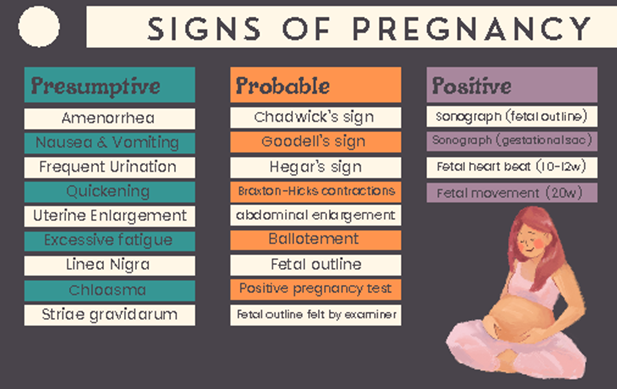A nurse in a prenatal clinic is completing a skin assessment of a client who is in the second trimester. Which of the following findings should the nurse expect? (Select all that apply.)
Striae gravidarum
Chloasma
Linea nigra
Eczema
Psoriasis
Correct Answer : A,B,C
Explanation:
A. Striae gravidarum: Also known as stretch marks, striae gravidarum are common during pregnancy due to the stretching and thinning of the skin as the uterus expands. They often appear as pink or purple streaks on the abdomen, breasts, hips, and thighs.
B. Chloasma: Chloasma, also called the "mask of pregnancy," refers to hyperpigmented areas on the face, typically appearing as brown patches on the cheeks, forehead, and upper lip. It is caused by hormonal changes during pregnancy and increased melanin production.
C. Linea nigra: Linea nigra is a dark line that develops vertically along the midline of the abdomen during pregnancy. It is caused by hormonal changes and increased pigmentation, and it typically fades after childbirth.
D. Eczema: Eczema, a skin condition characterized by red, itchy, and inflamed patches, may or may not be directly related to pregnancy. Some women may experience flare-ups of eczema during pregnancy due to hormonal changes or other factors, but it is not specific to the second trimester.
E. Psoriasis: Psoriasis, another skin condition characterized by red, scaly patches, may also flare up during pregnancy for some individuals. However, like eczema, it is not specific to the second trimester and can occur at any time.
Nursing Test Bank
Naxlex Comprehensive Predictor Exams
Related Questions
Correct Answer is A
Explanation
Explanation:
A. Report of headache
Severe preeclampsia is characterized by hypertension (high blood pressure) along with other signs and symptoms of preeclampsia, such as proteinuria (protein in the urine) and end-organ dysfunction. Headache is a common symptom associated with severe preeclampsia and is often described as persistent and severe.
B. Polyuria
Polyuria, or excessive urination, is not typically associated with severe preeclampsia. In fact, decreased urine output (oliguria) can be a concern in severe cases due to reduced kidney function and fluid retention.
C. Tachycardia
Tachycardia, or a rapid heart rate, is not a typical finding in severe preeclampsia. In fact, hypertension and vascular constriction associated with preeclampsia can lead to normal or even lower heart rates in some cases.
D. Absence of clonus
Clonus refers to rhythmic, involuntary muscle contractions and relaxations. In the context of preeclampsia, the presence of clonus (especially hyperreflexia and positive clonus) is a concerning sign associated with central nervous system irritability and potential seizures. Absence of clonus would not be an expected finding in severe preeclampsia, as neurological manifestations such as hyperreflexia and clonus can occur in more severe cases.
Correct Answer is D
Explanation
Explanation:
A. "This is a probable sign of pregnancy."
A probable sign of pregnancy is an objective finding observed by a healthcare provider that suggests the likelihood of pregnancy but does not confirm it definitively. Examples of probable signs include positive pregnancy tests (urine or blood tests), changes in the uterus (enlargement, softening), and changes in the cervix (Goodell's sign, Chadwick's sign). Sensations of fetal movement, such as the feeling of the baby moving, are actually presumptive signs of pregnancy rather than probable signs because they can have other explanations and are not definitive proof of pregnancy.
B. "This is a possible sign of pregnancy."
While sensations of fetal movement can be associated with pregnancy, they are more accurately classified as presumptive signs rather than possible signs. Possible signs typically refer to signs or symptoms that could be related to various conditions, including pregnancy, but do not specifically indicate pregnancy on their own. In this context, "possible" may not be as accurate as "presumptive" for describing fetal movement as a sign of pregnancy.
C. "This is a positive sign of pregnancy."
A positive sign of pregnancy is a definitive finding that confirms the presence of a fetus. Examples of positive signs include fetal heartbeat heard by Doppler or ultrasound, fetal movement felt by the healthcare provider (palpation), and visualization of the fetus on ultrasound. Sensations of fetal movement reported by the woman (quickening) are not considered positive signs because they can be subjective and may have other explanations, such as gas or muscle contractions.
D. "This is a presumptive sign of pregnancy."
A presumptive sign of pregnancy is a subjective sign reported by the woman that may indicate pregnancy but can also have other explanations. Examples include amenorrhea (missed periods), nausea and vomiting (morning sickness), breast changes, and sensations of fetal movement (quickening). Sensations of fetal movement are considered presumptive because they are subjective and can be caused by factors other than pregnancy, such as gas or muscle contractions.

Whether you are a student looking to ace your exams or a practicing nurse seeking to enhance your expertise , our nursing education contents will empower you with the confidence and competence to make a difference in the lives of patients and become a respected leader in the healthcare field.
Visit Naxlex, invest in your future and unlock endless possibilities with our unparalleled nursing education contents today
Report Wrong Answer on the Current Question
Do you disagree with the answer? If yes, what is your expected answer? Explain.
Kindly be descriptive with the issue you are facing.
